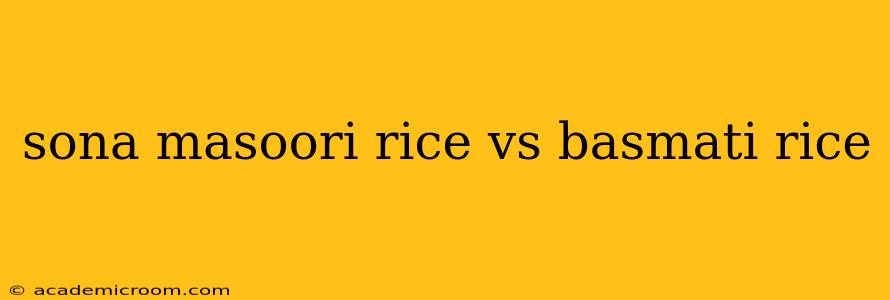Choosing the right rice can significantly impact the flavor and texture of your dish. While both Sona Masoori and Basmati rice are popular choices, they offer distinct characteristics that cater to different culinary preferences. This detailed comparison will help you understand the key differences between these two varieties and guide you in selecting the perfect rice for your needs.
What is Sona Masoori Rice?
Sona Masoori, meaning "gold treasure" in Kannada, is a short-grain, non-basmati rice variety predominantly cultivated in South India. Its popularity stems from its soft, fluffy texture after cooking, making it ideal for dishes requiring a delicate mouthfeel. Its mild flavor makes it a versatile option, complementing both sweet and savory dishes.
What is Basmati Rice?
Basmati, meaning "fragrant" in Hindi, is a long-grain aromatic rice primarily grown in the foothills of the Himalayas in India and Pakistan. Known for its distinct, nutty aroma and fluffy, non-sticky texture, Basmati rice is celebrated for its unique flavor profile and ability to retain its shape after cooking. This makes it a perfect accompaniment to curries and other flavorful dishes.
Sona Masoori Rice vs. Basmati Rice: Key Differences
| Feature | Sona Masoori Rice | Basmati Rice |
|---|---|---|
| Grain Length | Short | Long |
| Texture | Soft, fluffy, slightly sticky | Fluffy, non-sticky |
| Aroma | Mild | Strong, nutty, fragrant |
| Flavor | Mild, slightly sweet | Nutty, aromatic |
| Cooking Time | Relatively shorter | Relatively longer |
| Use Cases | Idli, dosa, kheer, rice pudding, biryanis | Biryanis, pilafs, curries, side dishes |
| Origin | South India | India & Pakistan (Himalayan foothills) |
What are the nutritional differences between Sona Masoori and Basmati rice?
While the nutritional profiles of Sona Masoori and Basmati rice are fairly similar, slight variations exist. Both are good sources of carbohydrates, providing energy. Basmati rice generally has a slightly lower glycemic index than Sona Masoori, meaning it may cause a slower rise in blood sugar levels. However, the precise nutritional content can vary depending on factors like growing conditions and processing methods. Always refer to the nutritional information provided on the packaging for the most accurate data.
Which rice is better for biryani?
Both Sona Masoori and Basmati rice can be used in biryani, but they yield different results. Basmati's long grains and distinct aroma make it a classic choice for biryani, providing a visually appealing and flavorful dish. Sona Masoori's softer texture contributes to a slightly different, creamier biryani experience. The choice often depends on personal preference and regional variations in biryani recipes.
Which rice is healthier?
Determining which rice is "healthier" is complex. Both offer nutritional benefits, but the differences are subtle. Basmati rice, with its potentially lower glycemic index, might be a slightly better choice for individuals managing blood sugar levels. Ultimately, incorporating both rice varieties into a balanced diet provides a wider range of nutrients.
Which rice is easier to cook?
Sona Masoori rice generally has a shorter cooking time than Basmati rice. This makes it a convenient option for quick meal preparation. However, both rice varieties are relatively straightforward to cook, following basic rinsing and cooking instructions.
Which type of rice is better for diabetics?
As mentioned earlier, Basmati rice may be a preferable choice for people with diabetes due to its potentially lower glycemic index compared to Sona Masoori. However, portion control and overall dietary habits remain crucial in managing diabetes. Consulting a healthcare professional or registered dietitian for personalized dietary advice is always recommended.
In conclusion, both Sona Masoori and Basmati rice offer unique culinary attributes. The best choice depends on your personal preferences, the desired texture and flavor profile, and the specific recipe you're preparing. Experimenting with both varieties will help you determine which one best suits your taste and cooking style.
